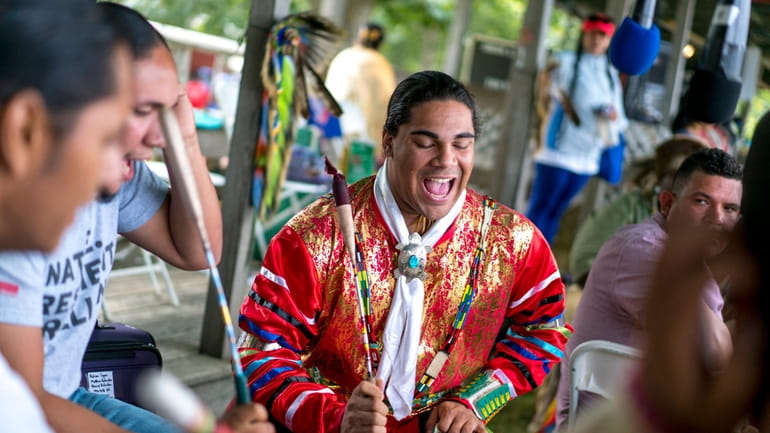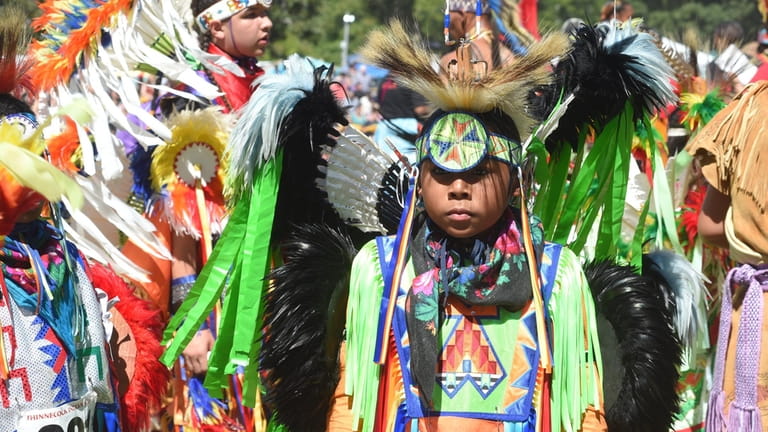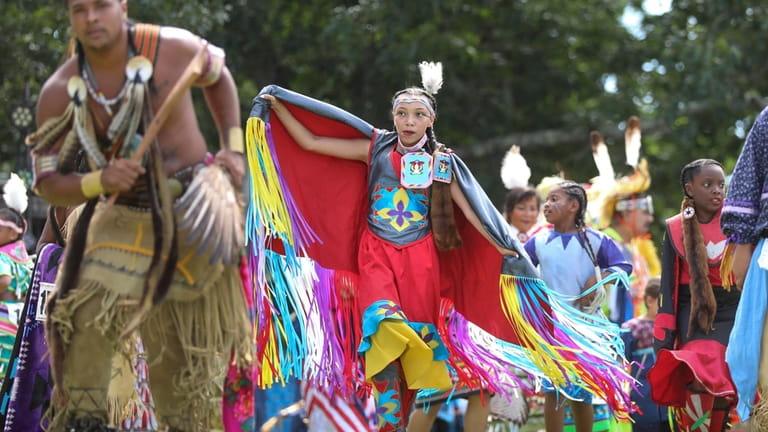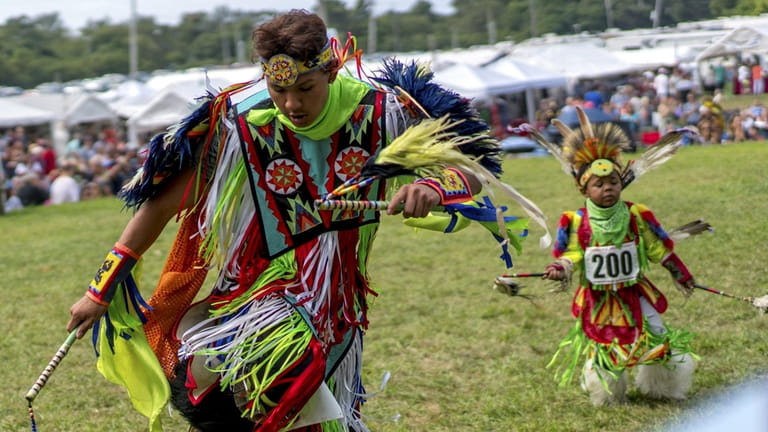Shinnecock Nation Powwow returns to Southampton Labor Day weekend

A Red Clay drummer performs at the annual Shinnecock Powwow in 2018. Credit: Johnny Milano
Come celebrate the end of the summer season with the Shinnecock Nation as the tribe welcomes the public to its 77th annual Indian Powwow in Southampton Sept. 1-4.
“This is the largest powwow on the Eastern Seaboard, drawing 30,000 over the course of the weekend. The entire grounds turn into a village with over 50 tribes from all over the country and Canada,” says Ferdinand Lee, assistant powwow committee coordinator. “It’s a gathering that celebrates our sacred grounds, our existence and our togetherness.”
MEET SACHEM SMITH
Sachem Charles K. Smith II serves as the master of ceremonies, responsible for instilling the traditions of the Shinnecock Nation as its spiritual leader.
“I welcome people to our land that our ancestors walked on for tens of thousands of years,” says Smith. “Shinnecock Nation is still here and strong as native people. Our goal is to show them some of that strength in our culture.”
Tribes such as Narragansett from Rhode Island, Ojibwe from Minnesota, Cree from Canada, Pequot from Connecticut, Sioux from North and South Dakota, Hopi from New Mexico and Arizona, Winnebago from Nebraska and Seminole from Florida are some that plan to join Shinnecock Nation throughout the weekend.
“People can wander around and learn about each tribe,” says Smith. “They will tell you about who they are and answer any questions.”
The Grand Entry kicks off the ceremony where all the tribes march in with traditional flags carrying different staffs representing their heritage and create a big circle with dignitaries and elders leading the way.
The main focus of the powwow is the series of traditional Native American dance competitions rated by a panel of judges. Certain dances are done by men while others are reserved for women, all of varying ages.

A participant at the Shinnecock Nation Powwow in Southampton in 2022. Credit: John Roca
- GRASS DANCE — This is a ceremonial dance done by men that started in the Northwest where the long Buffalo grass grows on the plains. “Men were once asked to bless the area before it was used for a celebration,” says Smith. “They would pay respect by adorning the grass on their outfits and lay the grass down flat.”
- JINGLE DRESS DANCE — This is a healing spiritual dance done by women that came from a young woman who was very ill but wanted to dance. Spirits visited her in a dream telling her about a special dress and how it was to be made. “There are seven layers of metal cones sewn around the dress, representing the seven directions of man — north, south, east and west, up to the heavens, down to the earth and into the heart,” says Smith. “The sound it makes is calming and healing.”
- EASTERN WAR DANCE — This dance represents men coming back to their villages from war and re-creating what they saw on the battlefield through dance. “For men, the Eastern War Dance is fast paced with hatchets and war sticks while screaming out war cries,” says powwow entertainment committee chair Susan Soto.
- EASTERN BLANKET DANCE — This is a courtship dance done by women from the eastern tribes. “This is a way for women to express their feelings for a special guy they had their eye on by dancing for these young men with their blankets showing their affection with different moves,” says Smith.
- FANCY FEATHER DANCE — This dance was created by a Native American man who wanted to implement more flash, style and excitement to traditional dances. “He adorned his outfit in brightly colored feathers, ribbons and bead work that was exuberant and fancy,” says Smith. “When stepping into the dance arena, he showed off his colors by dancing at a very fast pace.”
- FANCY SHAWL DANCE — The dance began as a female version of the Fancy Feather Dance, evoking the image of a butterfly or a bird. “The shawl dancers are the most interesting,” says Soto. “They whip those shawls around and their footwork timed with the drum beats is very exciting to watch.”
- ROUND DANCE — The audience gets to participate during this dance, which serves as a friendship dance. “Everybody holds hands and dances in a circle,” says Smith. “The steps are very easy to learn. It’s our way of saying welcome.”
DANCE DEDICATIONS AND SHOWS

Participants performed Native American dances at the Shinnecock Nation Powwow in Southampton in 2019. Credit: Neswsday/John Paraskevas
A series of special dances are interspliced between the dance competitions, sponsored by various tribes.
“When a tribe member passes, the family will hold a special dance in their honor,” says Soto. “The family will speak about the person and they’ll pick a category that the deceased used to dance in.”
A special dance will be held in honor of Chief Red Fox, who was Charles K. Smith Sr. — a leader on the Tribal board of trustees for more than 35 years.
“He was a traditional man who carried his traditions strong in his heart and his life,” says Smith of his father.
There are dances that are done strictly for entertainment purposes. The Kalpulli Huehuetlahtolli Aztec Dancers are set to perform the coveted Fire Dance.
“For us as indigenous people, fire is alive and has a spirit. It must be respected and communicated with,” says dance captain Eddie Jaramillo. “During the dance, we put our legs and feet over the flame. But you must learn a certain trust, so it doesn’t burn you.”
BLACKBIRD SWOOPS IN
Native American alternative rock fusion band Blackbird, which is based in Arizona, will play two 30-minute sets Sept. 2-3 and once on Sept. 4. The group is promoting its new album, “Existence is Resistance” featuring songs “Talk About the NDN,” "The World’s Alive,” “Superficial” and “What’s My Name.”
“There are songs on the album that poetically, musically and lyrically head in the direction of empowerment,” says lead singer/flutist Cody Blackbird. “After the hundreds of years our people have gone through, we are still here creating the artwork we want.”
TREATS AND VENDORS

Competitors perform during an exhibition at the annual Shinnecock Powwow in 2018. Credit: Johnny Milano
Around the perimeter of the powwow, each tribe will have a booth selling authentic Native American foods.
“Each nation brings different foods that range from buffalo burgers to quail to alligator to crabs to venison tacos,” says Lee. “Shinnecock’s menu will include clams stuffed, fried and on the half-shell as well as red clam chowder plus succotash.”
There will also be a marketplace selling handcrafts, art, jewelry, clothing and instruments.
“Everything is handmade by the members of the tribe,” says Smith. “Each vendor will tell you the meaning behind the item you are buying, where it comes from, what it means and how it was made.”
77th ANNUAL SHINNECOCK INDIAN POWWOW
WHEN | WHERE Sept. 1: Gates open at 3 p.m., Sept. 2-4: Gates open at 10 a.m.; 1 West Church St., Southampton
ADMISSION $23.18, $12.51 for kids ages 5-10
MORE INFO 631-283-6143, ext. 5, shinnecock-nsn.gov

